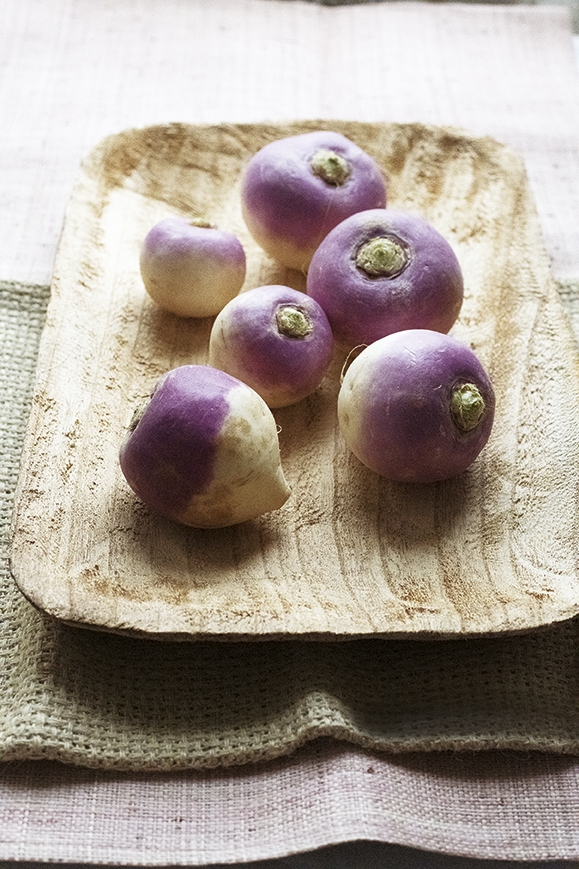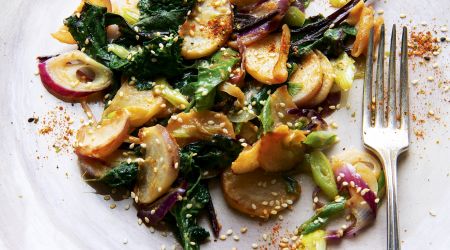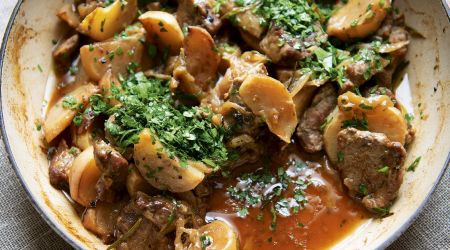Turnips
Infinitely versatile and surprisingly delicate, the humble turnip can enhance many a sophisticated dish. Clarissa Hyman explains why and Linda Tubby shows how
WHAT ARE THEY?
Pity the poor turnip, so often confused, at least in these isles, with its coarser and cruder cousin, the swede. Without going into detailed terminology and nomenclature distractions, let us just banish all thoughts of the fat yellow bruiser and focus instead on the delicate violet and ivory tones and svelte curves of the little cricket balls or even (if you’re lucky) home-grown tiny golf balls. Main crop or winter turnips are generally available between October and February and, as the bulbs get bigger, the flavour becomes more pronounced. Either way, avoid any that seem spongy, discoloured or with broken skin. But as winter fades, keep an eye out for the first spring bunches of softly glowing, young white ‘French’ turnips tinged with purple and tied together by pale jade stalks or ‘tops’.
One of the earliest cultivated vegetables, turnip aka Brassica rapa is thought to have originated in northern Europe in around 2,000 BC. Although these days we know it as a root, it is actually the swollen base of the stem. In Ancient Rome, the spindly wild plants were bred to produce many varieties of larger turnip, and were an important food, especially before the empire spread to include rich agricultural lands.
From the classical world, turnips spread through Asia to Northern China and thence to Japan. The Chinese tradition is to roast them or sun-dry and preserve them in soy sauce; whereas the Japanese particularly enjoy them pickled and carved into a chrysanthemum shape, although they also boil and eat them with yuzu-flavoured miso. Throughout Asia, the Middle East and North Africa turnips appear in spicy tagines, curries, stews and soups; pickled, they are immensely popular in the Arab world, frequently coloured pink by including a bit of beetroot in the pickling jar.
Although these vegetables have long been associated with poor farmers and tillers of the soil, they helped make Britain rich. As every schoolchild once knew, the Second Viscount ‘Turnip’ Townshend propelled the humble veg to fame in the 18th century, kicking off an agricultural revolution that helped make Britain
one of the richest countries in the world. Thanks to his efforts, the famous French nursery company Vilmorin-Andrieux listed in its catalogue 50 different varieties by the late 19th century, although most of these have now been lost.
TASTING NOTES
Turnips combine sweetness and pepperiness in perfect balance, a combination you can detect in their aroma when freshly dug. For most recipes, turnips need to topped and tailed and larger specimens should be peeled. Cooking time depends on age: young dice may only need five or ten minutes, while tougher older ‘roots’ can take up to an hour to become tender.
ANY BENEFITS?
If you grow your own turnips or buy them with their tops, be sure to cook the young leaves, which are part of the same family as greens such as kale and broccoli, as they are particularly high in vitamins A, C and K and contain minerals such as magnesium and calcium. However, the vegetable itself consists of 90 per cent water, albeit with traces of vitamins and minerals: the good news is they are very low in calories.
GOES WELL WITH
Jane Grigson praised the French-style pairing of turnips with navarin of lamb, duck, ham in port wine sauce or in a creamy soup. As she was quick to point out, their ability to absorb and profit from richness can then be seen – and tasted – to best advantage. Indeed, any addition of cream works brilliantly to bring out their natural sweetness and heat. You could try, for example making a creamy, garlicky dauphinoise with a 50:50 mix of potatoes and turnips. Spices such as ginger, cinnamon and garlic also have a natural affinity that can help avoid any risk of blandness and enhance exotic interest.
The German poet Goethe celebrated the combination of turnips with chestnuts despite the fact, as he pointed out, ‘These two noble products of the earth grow far apart.’
QUICK TIPS
If small enough, simply boil them whole and serve buttered generously. Or roast them in the same way as you would potatoes to accompany a joint, or in a mix of blanched parsnips, carrots, swedes and potatoes. Mark Diacono suggests adding a little honey and a pinch of cumin and/or coriander to bring out their inherent sweetness and spice. When sautéed or braised, they respond equally well to these additions.
Glazed turnips are particularly excellent – blanch and fry with butter and sugar until they are glossy and caramelised. Note, however, that as they grow in size, they have a tendency to become a touch woody, so factor that in when choosing.
Turnip tops or broccoletti di rapa or cime di rapa are a favourite spring vegetable in Rome, where they are chopped and cooked in fast-boiling salted water until just tender, then cooled and served with a lemon and oil dressing. They have a slightly bitter flavour that has become highly sought after by chefs. As Mark suggests, you can also shred and sauté them with olive oil and garlic to make a decent pasta sauce.
HOW TO SHOWCASE THEM
A dish of buttered turnips strewn with finely chopped herbs such as parsley, chives and tarragon, will impress with its elegant simplicity – go a step further and adorn them, retro-style, with a dab of double cream and triangles of fried bread for the ultimate in comforting winter sides.
Another recipe by Mark Diacono makes a bolder impact by adding turnips to a hearty, rustic stew of rabbit with fennel seeds, bay, apples and cider. Famed seafood chef Nathan Outlaw makes a fabulous combination of turbot steaks, seaweed, turnips and potatoes; and, sticking with the fish theme, James Martin makes the clever pairing of grilled mackerel with pickled turnip, asparagus and watercress.
ANYTHING ELSE?
Early-crop turnips will keep loosely wrapped in a paper bag for about two weeks in the bottom of the fridge if you remove the leafy tops, while main crops will keep much longer. Both can happily be blanched and then frozen.
The delightfully named orange jelly heritage turnip was raised by George Chivas of Chester and introduced by him in 1853 to great acclaim. A mid-season variety, it has quite a remarkable flavour: nutty and with a hint of bitter almond and sweet, tender yellow flesh, which gives it an almost jelly-like consistency when boiled – hence the name.
Sappho, a Greek poet from the 7th century BC, called one of her lovers Turnip. It can only have been meant affectionately.

Recipes
Get Premium access to all the latest content online
Subscribe and view full print editions online... Subscribe




